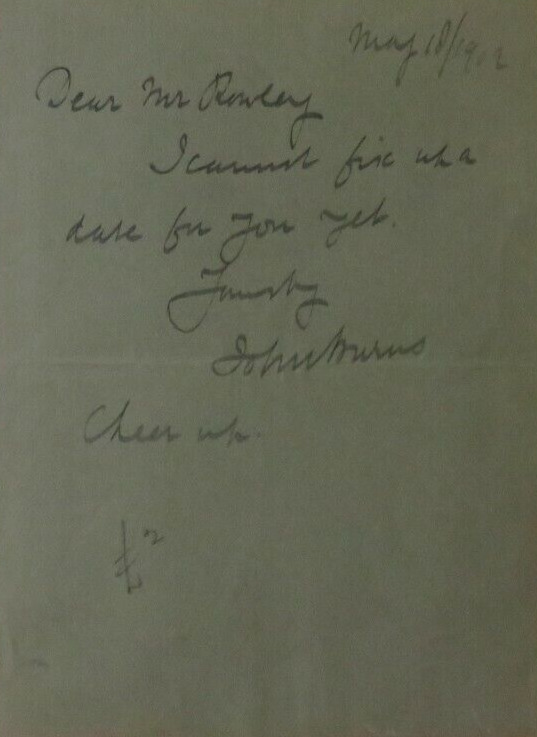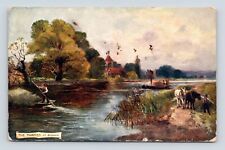"The Thames is Liquid History" John Burns Hand Written Note For Sale

When you click on links to various merchants on this site and make a purchase, this can result in this site earning a commission. Affiliate programs and affiliations include, but are not limited to, the eBay Partner Network.
"The Thames is Liquid History" John Burns Hand Written Note:
$299.99
Up for sale "The Thames is Liquid History" John Burns Hand Written Note On 4X5.5 Card.
ES-5447E
John
Elliot Burns (20 October 1858
– 24 January 1943) was an English trade unionist and politician, particularly associated
with London politics and Battersea. He was a socialist and then
a Liberal Member of
Parliament and Minister. He was anti-alcohol and a
keen sportsman. After retiring from politics, he developed an expertise
in London history and
coined the phrase "The Thames is liquid history". When the Liberal
cabinet made a decision for war on 2 August 1914, he resigned and played no
further role in politics. Burns was born in London in 1858, the son of Alexander Burns, a Scottish fitter, growing up with his railwayman father in
a house at 80 Grant Road, Battersea on what is now the Winstanley and York Road Estates. He attended he was ten years old.
He then had a succession of jobs until he was fourteen years old and started a
seven-year apprenticeship to an engineer at Millbank and continued his
education at night-schools. He read
extensively, especially the works of Robert Owen, John Stuart Mill, Thomas Paine and William Cobbett. A French fellow-worker, Victor Delahaye, who
had been present during the Paris Commune introduced him to socialist ideas, and
Burns claimed that he was converted because he found the arguments of J. S.
Mill against it to be insufficient. He began practising outdoor speaking, with
the advantage of exceptional physical strength and a strong voice. In
1878, he was arrested and held overnight for addressing an open-air
demonstration on Clapham Common. He worked
at his trade in various parts of England, having joined the Amalgamated
Society of Engineers in 1879. In 1881 he formed a branch of
the Social Democratic
Federation (SDF) in Battersea. He worked on a ship, and went for a year to the
West African coast at the mouth of the Niger as
a foreman engineer for the United Africa Company. He disapproved of treatment of Africans and spent his earnings on a six months' tour to
study political and economic conditions in France, Germany and Austria. Burns delivered a speech at the Industrial
Remuneration Conference in 1884 which attracted considerable attention, and in
that year he was elected to the Social Democratic Federation's executive
council. He stood for Parliament in the 1885 was unsuccessful. A year later, he took part in a
London demonstration against unemployment which resulted in the West End riots
when the windows of the Carlton Club and other London clubs were broken, where he
encouraged rioters to loot bakeries. He was arrested and later acquitted at
the Old Bailey of charges of conspiracy and sedition. He was arrested again the following year on 13
November 1887 for resisting police attempts to break up an unlicensed meeting
in Trafalgar Square. The
demonstration ended in the 'Bloody Sunday' clashes;
Burns was imprisoned for six weeks. In August 1889, Burns played a major part
in the London Dock Strike. By
this time he had left the SDF and, with fellow socialist Tom Mann, was focusing on trade union activity as a leader of
the New Unionist movement. With other London radicals such as Ben Tillett, Will Crooks and John Benn, Burns ('The Man
with the Red Flag') helped win the
dispute. He was still working at his trade in Hoe's printing machine works and
was an active member of the executive of the Amalgamated Engineers' Union. In
1889, he became a Progressive member of
the first London County Council for Battersea.
He was supported by his constituents, who subscribed an allowance of £2 a week.
He devoted his efforts against private monopolies and introduced a motion in
1892 that all contracts for the County Council should be paid at trade union
rates and carried out under trade union conditions. As a local politician,
Burns is particularly noted for his role in the creation of Battersea's Latchmere Estate, the first municipal housing estate built using a council's own
direct labour force, officially opened in 1903. He was connected with the Trades Union Congresses until
1895.

Related Items:
The Thames At Bisham Raphael Tuck Oilette Artist J.T. Adams 1907 DB Postcard L5
$2.66
"The Thames is Liquid History" John Burns Hand Written Note
$209.99
JUNCTION OF THE THAMES AND MEDWAY (J. M. W. Turner) Card GleeBeeCo #JNJM-L /49
$69.00



